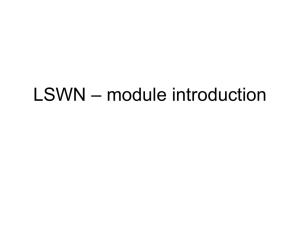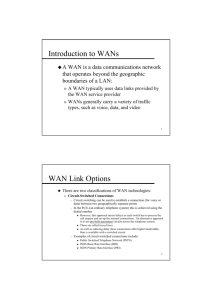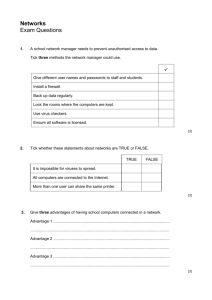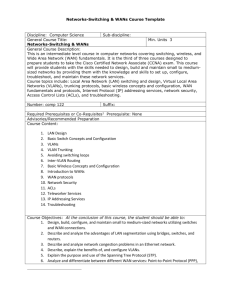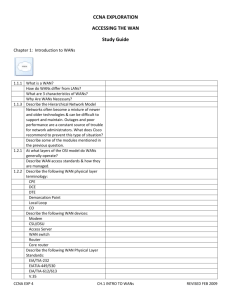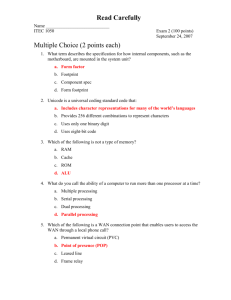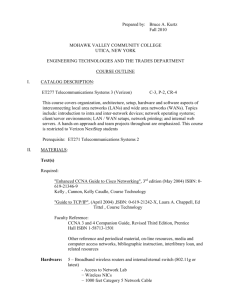lec10_WANs_part1
advertisement
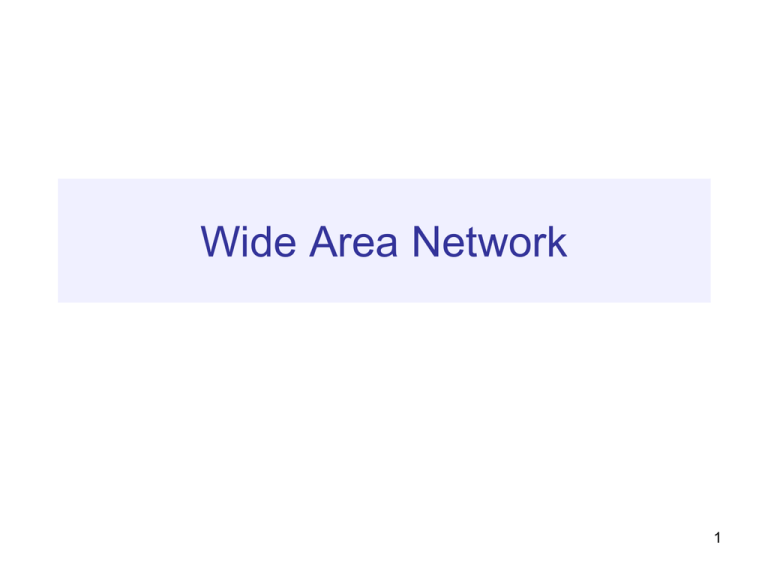
Wide Area Network 1 What is a WAN? • A wide area network (WAN ) is a data communications network that covers a relatively broad geographic area and that often uses transmission facilities provided by common carriers, such as telephone companies. 2 LANs and WANs LAN • A LAN connects computers, peripherals, and other devices in a single building or other small geographic area. • LANs typically are owned by the company or organization that uses them. WAN • A WAN allows the transmission of data across greater geographic distances. • An enterprise must subscribe to a WAN service provider to use WAN carrier network services. 3 WAN • Here are the three major characteristics of WANs: – WANs generally connect devices that are separated by a broader geographic area than can be served by a LAN. – WANs use the services of carriers, such as telephone companies, cable companies, satellite systems, and network providers. – WANs use serial connections of various types to provide access to bandwidth over large geographic areas. 4 WAN Users • WANs are used to connect local area networks (LANs) together, so that users and computers in one location can communicate with users and computers in other locations. • Many WANs are private that uses either dedicated or switched communication link. • Others are public that use the global Internet infrastructure. 5 6 WAN and OSI • WAN technologies generally function at the lower three layers of the OSI reference model: the physical layer, the data link layer, and the network layer. 7 8 How to Build a WAN? • WANs are most often built using leased lines. At each end of the leased line, a router connects to the LAN on one side and a hub within the WAN on the other. • A set of switches and routers are interconnected to form a Wide Area Network. The switches can be connected in different topologies such as full mesh and half mesh. 9 Internet WAN 10 11 1- Dedicated (Point-to-Point) Connection • A point-to-point link provides a single, pre-established WAN communications path from the customer premises through a carrier network to a remote network (It is a permanent full time connection). • Point-to-point lines are usually leased from a carrier and thus are often called leased lines. • For a point-to-point line, the carrier allocates pairs of wire and facility hardware to this user only. 12 1- Dedicated (Point-to-Point) Connection • These circuits are generally priced based on bandwidth required and distance between the two connected points. Advantage: Line is always reserved for the user Disadvantage: Expensive 13 2- Switched Network • Switched network - Several users share the same line or the bandwidth of the line. There are two types of switched networks: – Circuit switching – Packet switching 14 2.1 - Circuit Switching • Circuit Switching allows data connections to be established when needed and then terminated when communication is complete. • This works like a normal telephone line works for voice communication. • When a router has data for a remote site, the switched circuit is initiated. • When the two networks are connected and authenticated, they can transfer data. • When the data transmission is complete, the call can be terminated. 15 2.1 - Circuit Switching • Cost is determined by the connection time. • Examples: ISDN Advantage: Cheap Disadvantage: • Network is reserved for the connection even if no data is sent. • Any failure in circuits will stop the connection, and require another call to reserve a new circuits. • Some times you wait until network is ready. 16 2.2 - Packet Switching • Many WAN users do not make efficient use of the fixed bandwidth that is available with dedicated or switched circuits, because the data flow fluctuates. • Packet switching is a WAN technology in which users share common carrier resources. • It splits traffic data into packets that are routed over a shared network. • Packet-switching networks do not require a circuit to be established, and they allow many pairs of nodes to communicate over the same channel 17 2.2 - Packet Switching • Because this allows the carrier to make more efficient use of its infrastructure, the cost to the customer is generally much better than with point-to-point lines. • Examples of packet switching technologies: X.25, ATM, Frame relay Advantages: – Fast, but slower than circuit switching. – Cheap – Connection is always there , due to many paths that data can move through 18 3- Public WAN connection • Public connections use the global Internet infrastructure. • Until recently, the Internet was not a viable networking option for many businesses because of the significant security risks and lack of adequate performance guarantees in an end-to-end Internet connection. • However, with the development of Virtual private network (VPN) technology, the Internet is become an inexpensive and secure option for connecting. 19 Virtual private network (VPN) • Is a technology widely used in a public network to provide private and secured WAN for an organization. • VPN uses encryption and other techniques to make it appear that the organization has a dedicated network, while making use of the shared infrastructure of the WAN. 20 21
